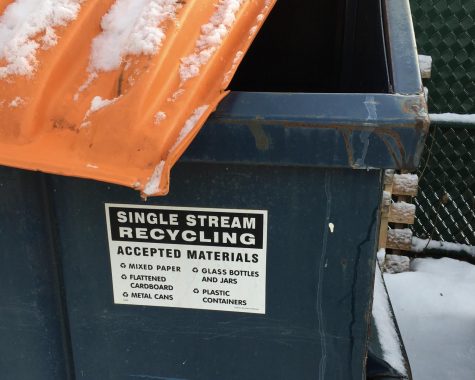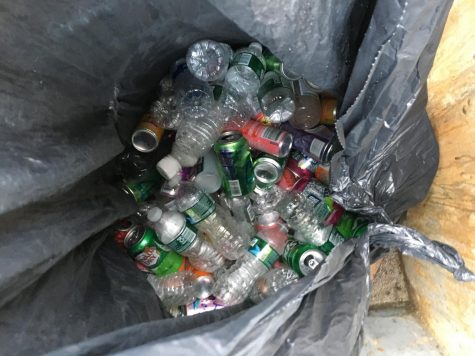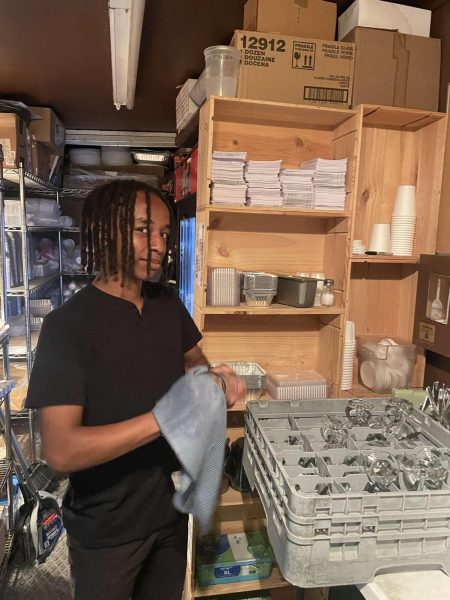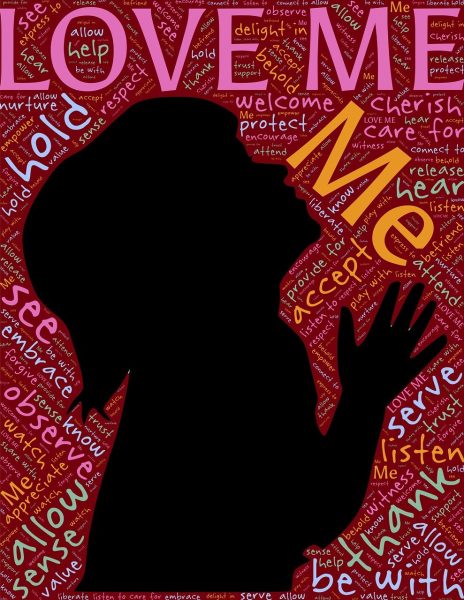We’re Rubbish at Recycling
How can we solve our recycling crisis?
Recycling is simple, or so we’ve been taught. Just throw your paper, plastic, and metal in the blue bins and forget about it. If you’re really an overachiever you might even unscrew the lid from your water bottle before giving it a toss. This current system, single-stream, is effortless.

The RHS recycling dumpster clearly dictates what Welch’s single-stream system accepts.
But this convenience comes at a cost.
Single-stream allows all recyclable materials, including paper, plastic, and metal to be thrown in the same bin. They are then sorted out by a plant called a Materials Recovery Facility or MRF, and then resold to re-processors, the facilities that actually recycle paper, cans and bottles into new goods.
It’s convenient for consumers, which studies have shown encourages those who may have been reluctant to start recycling. Some municipalities, like Grand Rapids Michigan, reported as much as a 40% increase in tonnage following a switch to single-stream. And more tonnage means bigger profits for MRFs.
On the surface, this sounds like a win-win: bigger profits, lower costs, more recycling overall.
Unfortunately, the benefits of single-stream are only an illusion.
The final stop for recyclable goods are re-processing facilities. There, recyclables are turned into new items. The most efficient re-processing facility would be able to reuse 100% of the materials they receive. But realistically, they reuse much less than 100%.
The re-processors’ priority is quality. They can only make a profit off of whatever they are able to reuse. Contaminated or dirty goods, called residuals, must be sent to a landfill. The higher the percentage of residuals in the materials re-processors receive, the less they can actually recycle. Overall tonnage does not matter to them, only usable tonnage.
Single-stream makes it easy for consumers to produce dirty, unusable recycling. Allowing everything to be thrown in one bin makes it more likely that someone will throw something in that doesn’t belong. It communicates the message that recycling is a mindless process.
Single-stream also encourages “wish-cycling,” or the process in which consumers throw pizza boxes, plastic bags, or other non-recyclable goods in the blue bin, hoping that they can somehow be recycled. While well-intentioned, “wish-cycling” is making single-stream recycling largely contaminated.
Not only does single-stream propagate carelessness in what we recycle, but when usable materials are together in the bin, they are much more likely to be contaminated by other goods. For example, wet paper, which could be dealt with if it had been brought isolated to an MRF, contaminates a huge percentage of the incoming glass. Due to the not-so-delicate process of single-stream collection, much of the glass breaks, making it even harder to separate from the paper. Multi-stream systems are so effective that hardly any glass is sent to a landfill. Single-stream sends as much as 40 percent.
Dual-stream recycling (in which consumers place metal and plastic in a separate bin from paper) produces residuals at a rate of only about 2-3 percent. Following a switch to single-stream, some municipalities report as much as 16.6 percent. That is 8 times as many residuals.
If one contaminated item, like a greasy pizza box, wet paper, or shattered glass, is found in a bin, it will contaminate the whole thing. The whole bin, including everything that could have been recycled, is sent to a landfill.
Even worse, single-stream is not even cheaper for consumers because, while collection costs are lowered for MRFs, re-processing facilities costs skyrocket. They either have to invest large sums in cleaning technology or have to send goods to landfills. Both options limit their profits and contribute to the increasing cost of recycling for consumers once again.
If municipalities want to increase their tonnage, a cleaner way would be to simply put in the effort in promoting and publicizing a dual- or multi-stream system.
It’s easy to pretend this problem doesn’t exist. Nobody wants to spend their time discussing waste. Nevertheless, it’s staring us in the face at RHS, and some people are catching on.
Most students or faculty wouldn’t think to look inside our dumpsters to see what our output truly looks like. But if you did, you’d likely find what we at Rhinebeck Reality found: bags of contaminated recycling in the trash dumpster and a largely empty recycling dumpster. We are so consistently irresponsible in our recycling habits that, according to our head of facilities Mr. Tieder, “Custodians probably get in the habit of tying up the recycling and just putting it in with the regular garbage.”

Contaminated cans and bottles found in the RHS trash dumpster.
Our carelessness is having direct and immediate consequences right here in our community. It’s fully within our power to stop this in our school. While we may be stuck with single-stream for the time being, it’s still our responsibility to recycle responsibly.
Katie Hall, President of the Environmental Club, stresses that “Students need to understand that when they put something wrong into the recycling bins, the recycling is thrown away.”
It’s no secret that single-stream is on the way out. Kingston has already made the switch. Rhinebeck could be next. But if Rhinebeck does make the change, will we be ready? If we can’t effictly police ourselves using the simplest methods, how can we be ready to sort using a multi- or dual-stream system? We need to start checking with our waste management services instead of wish-cycling. We need to stop contaminating good recycling so severely that it gets thrown out with the trash. We need to start improving now.







